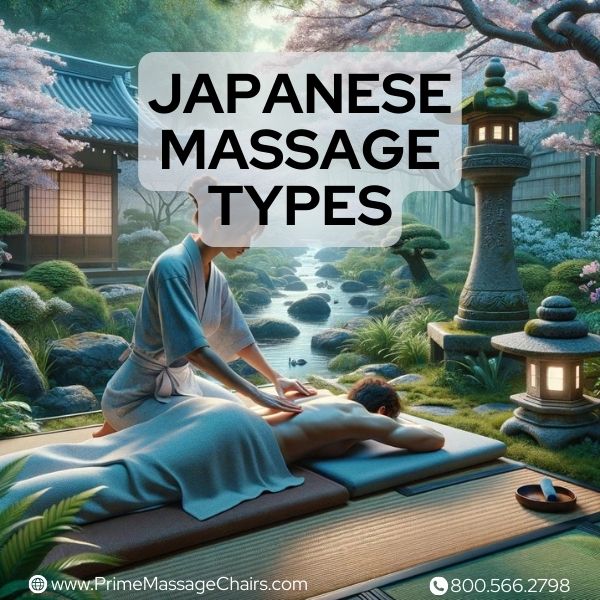
Japanese Massage Types
Are you curious about the Japanese massage types and looking to experience the ancient art of Japanese massage?
Massage techniques originating from Japan have been practiced for centuries.
This article explores the different types of Japanese massage, their techniques, and potential benefits.
Keep reading to discover the rejuvenating world of Japanese massage.
Understanding Japanese Massage
Japanese massage, while influenced by traditional Chinese medicine, has evolved into a unique form that incorporates Japan's own cultural and therapeutic practices.
It aims to promote natural healing by manipulating the body's pressure points and energy channels.

Definition and History
Japanese massage has its roots in Anma. Anma means pressing and rubbing.
These techniques evolved over thousands of years, likely influenced by ancient Chinese and Indian practices.
A blind acupuncturist named Sugiyama Waichi popularized Anma during the 17th century.
The professionalization and spread of Anma were also supported by the establishment of schools for the blind, where massage was taught as a viable profession for visually impaired individuals.
Shiatsu, Kobido, and Anma are distinct Japanese massage types.
Understanding their definition and history helps appreciate their uniqueness.
Connection between Anma and Shiatsu massage
Anma and Shiatsu share foundational techniques, but Shiatsu specifically focuses on pressure points and energy pathways distinct from the more general approach of Anma.
Shiatsu additionally incorporates elbow pressure and gradual application.
While sharing foundational techniques with Anma, Shiatsu evolved to place greater emphasis on the diagnostic and therapeutic application of pressure along the body's meridians, distinguishing it as a distinct form of massage therapy focused on health and well-being.
Shiatsu involves using fingers, palms, elbows, and knees to apply pressure along meridians.
Anma focuses on rubbing, pressing, and stretching muscles.
Both aim to promote energy flow, relieve tension, and improve overall wellbeing.
Different Types of Japanese Massage
Japanese massage encompasses various techniques rooted in traditional healing practices.

Shiatsu, Kobido, and Anma are distinct massage forms that offer unique benefits and approaches.
Shiatsu
Shiatsu massage originated from ancient Japanese anma techniques. It involves applying pressure along the body's meridians to promote energy flow.
Shiatsu therapists utilize finger pressure on specific points to relieve stress, muscle tension, and various medical conditions.
This holistic approach aims to restore balance, enhancing mental clarity and overall well-being.
Shiatsu incorporates stretching, rocking motions, and rhythmic compression.
Practitioners employ thumbs, palms, elbows, and even feet to apply pressure.
Shiatsu's benefits extend beyond physical relief, fostering emotional harmony and relaxation.
Kobido
Kobido, known for its focus as a Japanese facial massage technique, aims primarily at aesthetic improvements such as enhancing skin elasticity, firmness, and overall facial appearance.
It focuses on aesthetic benefits like enhanced elasticity, firmness, brighter complexion, reduced puffiness.
The massage stimulates muscles, lymphatic system, enhancing drainage.
Practitioners use gentle finger pressure, stretching techniques along energy pathways.
Now let's move on to the next Japanese massage type, Anma.
Anma
Departing from Kobido, Anma is another traditional Japanese massage technique rooted in principles of Traditional Chinese Medicine.
It involves applying pressure using hands, thumbs, fingers, elbows, and feet to specific meridian points on the body.
Anma aims to relieve muscle tension, improve circulation, and reduce stress.
This centuries-old massage promotes healing and relaxation by manipulating the body's energy pathways.
Practitioners use various techniques like rocking, elongation, rotation, and pressure to restore balance.
Anma aims to alleviate chronic pain, menstrual cramps, and migraines while enhancing overall well-being.
Techniques Involved in Japanese Massage

Japanese massage incorporates various techniques to induce relaxation and improve bodily functions.
These techniques primarily involve applying controlled pressure, stretching, and rocking motions to specific areas of the body.
Rocking
Rocking involves rhythmic movements that promote relaxation.
Japanese massage therapists employ these gentle, wave-like motions to release tension, enhance circulation, and restore harmony within the body.
Rocking techniques help align the mind and body, cultivating a profound sense of tranquility.
Transitioning seamlessly, elongation forms another integral aspect of Japanese massage methods.
Pressure
Japanese massage places great emphasis on pressure. Practitioners apply firm but gentle pressure using their palms, thumbs, and fingers.
This targeted pressure stimulates specific points on the body, promoting circulation and releasing muscle tension.
Applying varying degrees of pressure is crucial in Japanese massage techniques like shiatsu and anma.
Masseuses meticulously control the intensity to achieve deep relaxation and overall well-being.
Pressure techniques differentiate Japanese massage from other modalities.
Exerting precise pressure on acupressure points unlocks energy flow, alleviating discomfort.
Masseuses strategically distribute pressure across the body, kneading and stretching soft tissues.
Elongation
Elongation plays a crucial role in Japanese massage. Therapists gently stretch muscles using firm pressure and rhythmic motions.
This elongation technique improves circulation, reduces tension, and increases flexibility.
Japanese massages emphasize elongating muscles through stretching and rhythmic kneading.
Elongation promotes relaxation by releasing muscle tightness. Improved flexibility and reduced discomfort are notable benefits.
Rotation
Japanese massage techniques embrace rotational movements. Rotation promotes relaxation, stress relief, and improved circulation.
Shiatsu and Anma utilize rotation differently, targeting pressure points for holistic well-being.
Rotational motions alleviate muscle stiffness, release tension, and enhance flexibility.
Circular and rotational techniques are integral to Japanese massage.
These movements thoroughly address tension, enabling a comprehensive approach to relaxation.
Rotation reaches specific pressure points, improving circulation and overall physical health.
Benefits of Japanese Massage
Japanese massage offers numerous potential benefits for physical and mental well-being.
It aims to reduce muscle tension, alleviates pain, and promotes relaxation.
Shiatsu massage is believed to energize the body and may help in relieving symptoms of anxiety, depression, and stress, although individual experiences can vary.
Anma massage combats chronic fatigue, aids restful sleep, and eases muscle/joint discomfort.
These massages improve blood circulation, boosting overall health.
Japanese massage techniques employ specific pressure points and stretching methods.
This stimulates energy flow, enhancing the body's self-healing capabilities. Improved flexibility and range of motion are additional advantages.
Regular sessions may lower blood pressure and strengthen the immune system.
The therapeutic effects contribute to a balanced, revitalized state of being.
While many people find Japanese massage beneficial, it's important to remember that individual responses to massage can vary widely.
Consulting with a healthcare professional is recommended, especially for those with specific health conditions, to ensure that massage therapy is a suitable complement to your health regimen.
Let's take a look at some of the potential risks and side effects of Japanese massage.
Potential Risks and Side Effects of Japanese Massage
Japanese massage carries minor risks. Individuals may feel slight discomfort during Shiatsu. It's important to communicate with your therapist about any discomfort during the session, as adjustments can be made to ensure a positive experience.
For individuals with conditions like unhealed wounds, tumors, abdominal hernias, recent fractures, and infectious skin diseases, it's important to consult with a healthcare professional before undergoing any massage therapy, including Japanese massage techniques.
While Shiatsu has been beneficial for many, further research is ongoing to fully understand its effectiveness and potential risks across a wider range of conditions.
Individuals with chronic conditions or those undergoing radiation therapy should consult their healthcare provider before starting any massage therapy to ensure it is safe for their specific health situation.
Certain precautions ensure a safe Japanese massage experience.
Consult your physician before undergoing massage, especially if pregnant or have osteoporosis.
Avoid massage after recent injuries or surgeries.
Listen to your body and inform the practitioner if feeling pain or discomfort.
Drinking water and resting after the session aids recovery.
Japanese massage offers therapeutic benefits when performed correctly and responsibly.
Proper training minimizes risks, making it a viable holistic treatment option.
FAQs
What is the history of Japanese massage?
Japanese massage has its roots in traditional Chinese massage and oriental medicine practices that have been around for centuries.
What are some common types of Japanese massage?
While shiatsu and anma are among the most recognized types, Japanese massage also includes other techniques such as Kobido for facial rejuvenation, highlighting the diversity within Japanese therapeutic practices.
Can Japanese massage help with specific health issues?
Yes, Japanese massage can potentially provide relief for conditions like lower back pain, arthritis, and menstrual disorders. It promotes overall wellness.
How does Japanese massage differ from other massage therapies?
Distinct from deep tissue or Swedish massage, which often use oils or lotions, Japanese massage focuses on pressure points and may incorporate limited use of lubricants.
It incorporates stretches and applies pressure using the practitioner's fingers, palms, elbows, knees and feet.
Who can benefit from Japanese massage?
Japanese massage can benefit people of all ages and backgrounds. It is often recommended for stress reduction, improving flexibility, and boosting overall health.
Where can I get an authentic Japanese massage?
You can find trained Japanese massage therapists at specialized clinics, spas, and wellness centers that focus on holistic health and alternative therapies.
Conclusion
We hope you feel more educated on the Japanese massage types and found this article helpful.
Japanese massage can be a great way to help your body and mind feel better.
It uses old methods like Shiatsu, Kobido, and Anma to make you feel relaxed and healthy.
These massages can make your muscles less tense, help you sleep better, and give you more energy.
If you're feeling stressed or just want to try something new to feel good, Japanese massage might be right for you.
Always consult your healthcare provider before beginning any new treatment or therapy to ensure it is appropriate for your specific health situation.
Disclaimer:
We do not provide medical advice. The content of this article, including text, graphics, and other material, is for informational purposes only. It is not intended to be a substitute for professional medical advice, diagnosis, or treatment. Always seek the advice of your physician or other qualified health provider with any questions you may have regarding a health condition. Never disregard professional medical advice or delay in seeking it because of something you have read in this article or on our website.
